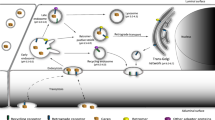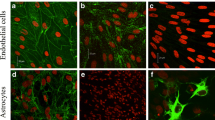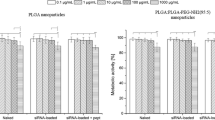Abstract
Purpose. Using polarized bovine brain microvessel endothelial cells (BBMEC) monolayers as in vitro model of the blood brain barrier and Caco-2 monolayers as a model of the intestinal epithelium, the present work investigates the effects of Pluronic P85 block copolymer (P85) on the transport of the P-gycoprotein (P-gp)- dependent probe, rhodamine 123 (R123).
Methods. The permeability and cell efflux studies are performed with the confluent cell monolayers using Side-Bi-Side diffusion cells.
Results. At concentrations below the critical micelle concentration, P85 inhibits P-gp efflux systems of the BBMEC and Caco-2 cell monolayers resulting in an increase in the apical to basolateral permeability of R123. In contrast, at high concentrations of P85 the drug incorporates into the micelles, enters the cells and is then recycled back out to the apical side resulting in decrease in Rl 23 transport across the cell monolayers. Apical to basolateral permeability of micelle-incorporated R123 in BBMEC monolayers was increased by prior conjugation of P85 with insulin, suggesting that modified micelles undergo receptor-mediated transcytosis.
Conclusions. Pluronic block copolymers can increase membrane transport and transcellular permeability in brain microvessel endothelial cells and intestinal epithelium cells. This suggests that these block copolymers may be useful in designing formulations to increase brain and oral absorption of select drugs.
Similar content being viewed by others
REFERENCES
S. Y. Lin and Y. Kawashima. Pluronic surfactants affecting diazepam solubility, compatibility, and adsorbtion from i.v. admixture solutions. J. Parenter. Sci. Technol. 41:83-87 (1987).
A. V. Kabanov, V. P. Chekhonin, V. Yu. Alakhov, E. V. Batrakova, A. S. Lebedev, N. S. Melik-Nubarov, S. A. Arzhakov, A. V. Levashov, G. V. Morozov, E. S. Severin, and V. A. Kabanov. The neuroleptic activity of haloperidol increases after its solubilization in surfactant micelles. Micelles as microcontainers for drug targeting. FEBS Lett. 258:343-345 (1989).
A. Rolland, J. O'Mullane, P. Goddard, L. Brookman, and K. Petrak. New macromolecular carriers for drugs. 1. Preparation and characterization of poly(oxyethylene-b-isoprene-b-oxyethylene) block copolymer aggregates. J. Appl. Polym. Sci. 44:1195-1203 (1992).
G. S. Kwon, M. Naito, M. Yokoyama, T. Okano, Y. Sakurai, and K. Kataoka. Physical entrapment of adriamycin in AB block copolymer micelles. Pharm. Res. 12:192-195 (1995).
S. A. Hagan, A. G. A. Coombes, M. C. Garnett, S. E. Dunn, M. C. Davies, L. Illum, S. S. Davis, S. E. Harding, S. Purkiss, and P. R. Gellert. Polylactide-poly(ethylene glycol) copolymers as drug delivery systems. 1. Characterization of water dispersible micelle-forming systems. Langmuir 12:2153-2161 (1996).
X. Zhang, J. K. Jackson, and H. M. Burt. Development of amphiphilic block copolymers as micellar carriers of taxol. Int. J. Pharm. 132:195-206 (1996).
A. V. Kabanov, E. V. Batrakova, N. S. Melik-Nubarov, N. A. Fedoseev, T. Yu. Dorodnich, V. Yu. Alakhov, V. P. Chekhonin, I. R. Nazarova, and V. A. Kabanov. A new class of drug carriers: micelles of poly(oxyethylene)-poly(oxypropylene) block copolymers as microcontainers for drug targeting from blood in brain. J. Contr. Rel. 22:141-158 (1992).
V. Yu. Alakhov, E. Yu. Moskaleva, E. V. Batrakova, and A. V. Kabanov. Hypersensitization of multidrug resistant human ovarian carcinoma cells by Pluronic P85 block copolymer. Bioconjugate Chem. 7:209-216 (1996).
A. Venne, S. Li, R. Mandeville, A. V. Kabanov, and V. Yu. Alakhov. Hypersensitizing effect of Pluronic L61 on cytotoxic activity, transport, and subcellular distribution of doxorubicin in multiple drug-resistant cells. Cancer Res. 56:3626-3629 (1996).
D. W. Miller, E. V. Batrakova, T. O. Waltner, V. Yu. Alakhov, and A. V. Kabanov. Interactions of Pluronic block copolymers with brain microvessel endothelial cells: evidence for multiple absorption pathways. Bioconjugate Chem. 8:649-657 (1997).
E. V. Batrakova, H.-Y. Han V. Yu. Alakhov, D. W. Miller, and A. V. Kabanov. Effects of Pluronic block copolymers on drug absorption in Caco-2 cell monolayers. Pharm. Res. 15:850-855 (1998).
D. W. Miller, K. L. Audus, and R. T. Borchardt. Application of cultured bovine brain endothelial cells of the brain microvasiculature in the study of the blood-brain barrier. J. Tiss. Clt. Meth. 14:217-224 (1992).
J. Fogh, J. M. Fogh, and T. J. Orfeo. One hundred and twenty seven cultured human cell lines producing tumors in nude mice. J. Natl. Cancer Inst. 59:221-226 (1977).
P. Artursson. Epithelial transport of drugs in cell culture. I: A model for studying the passive diffusion of drugs over intestinal absorptive (Caco-2) cells. J. Pharm. Sci. 79:476-482 (1990).
D. C. Dawson. Na and Cl transport across the isolated turtle colon: parallel pathways for transmural ion movement. J Membrane Biol. 37:213-233 (1977).
K. I. Hosoya, K. J. Kim, and V. H. Lee. Age-dependent expression of P-glycoprotein gp170 in Caco-2 cell monolyers. Pharm. Res. 13:885-890 (1996).
E. Beaulieu, M. Demeule, L. Ghitescu, and R. Beliveau. P-glycoprotein is strongly expressed in the luminal membranes of the endothelium of blood vessels in the brain. Biochem. J. 326:539-544 (1997).
D. W. Miller, B. T. Keller, and R. T. Borchardt. Identification and distribution of insulin receptors on cultured bovine brain microvessel endothelial cells: possible function in insulin processing in the blood-brain barrier. J. Cell. Physiol. 161:333-341 (1994).
A. V. Kabanov, I. R. Nazarova, I. V. Astafieva, E. V. Batrakova, V. Yu. Alakhov, A. A. Yaroslavov, and V. A. Kabanov. Micelle formation and solubilization of fluorescent probes in poly(oxyethylene-b-oxypropylene-b-oxyethylene) solutions. Macromolecules 28:2303-2314 (1995).
D. Lasic and F. Martin, Eds. Stealth Liposomes. CRS Press, Boca Raton, 1995.
M. M Nerurkar, P. S. Burton, and R. T. Borchardt. The use of surfactants to enhance the permeability of peptides through Caco-2 cells by inhibition of an apically polarized efflux system. Pharm. Res. 13:528-534 (1996).
M. M. Nerurkar, N. F. H. Ho, P. S. Burton, T. J. Vidmar, and R. T. Borchardt. Mechanistic roles of neutral surfactants on concurrent polarized and passive membrane transport of a model peptide in Caco-2 cells. J. Pharm. Sci. 7:813-821 (1997).
V. I. Slepnev, L. E. Kuznetsova, A. N. Gubin, E. V. Batrakova, V. Yu. Alakhov, and A. V. Kabanov. Micelles of poly(oxyethylene)-poly(oxypropylene) block copolymer (pluronic) as a tool for low-molecular compound delivery into a cell. Phosphorylation of intracellular proteins with micelle incorporated [γ−32P]ATP. Biochem. Internat. 26:587-595 (1992).
D. Leveque, and F. Jehl. P-glycoprotein and pharmacokinetics. Anticancer Res. 15:331-336 (1995).
C. G. Lee, M. M. Gottesman, C. O. Cardarelli, M. Ramachandra, K. T. Jeang, S. V. Ambudkar, I. Pastan, and S. Dey. HIV-1 protease inhibitors are substrates for the MDR1 multidrug transporter. Biochemistry 37:3594-3601 (1998).
N. Drion, P. Risede, N. Cholet, C. Chanez, J. M. Scherrmann. Role of P-170 glycoprotein in colchicine brain uptake. J. Neurosci. Res. 49:80-88 (1997).
Author information
Authors and Affiliations
Rights and permissions
About this article
Cite this article
Batrakova, E.V., Han, HY., Miller, D.W. et al. Effects of Pluronic P85 Unimers and Micelles on Drug Permeability in Polarized BBMEC and Caco-2 Cells. Pharm Res 15, 1525–1532 (1998). https://doi.org/10.1023/A:1011942814300
Issue Date:
DOI: https://doi.org/10.1023/A:1011942814300




